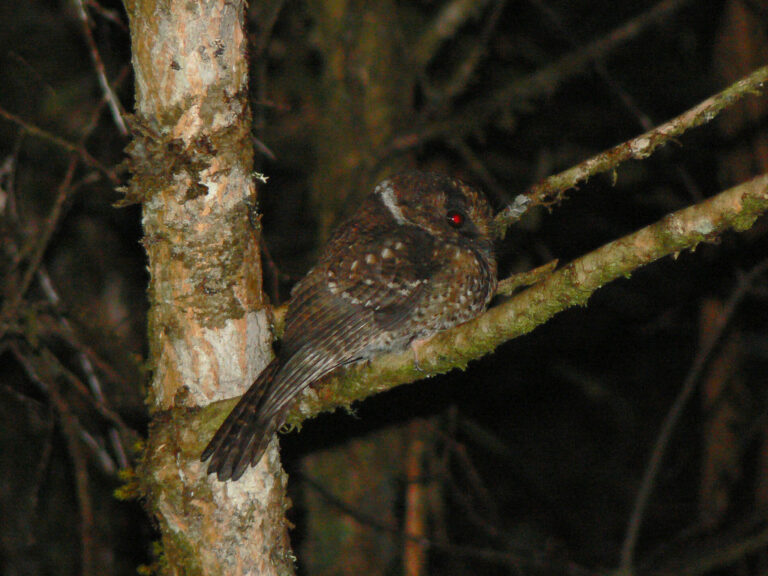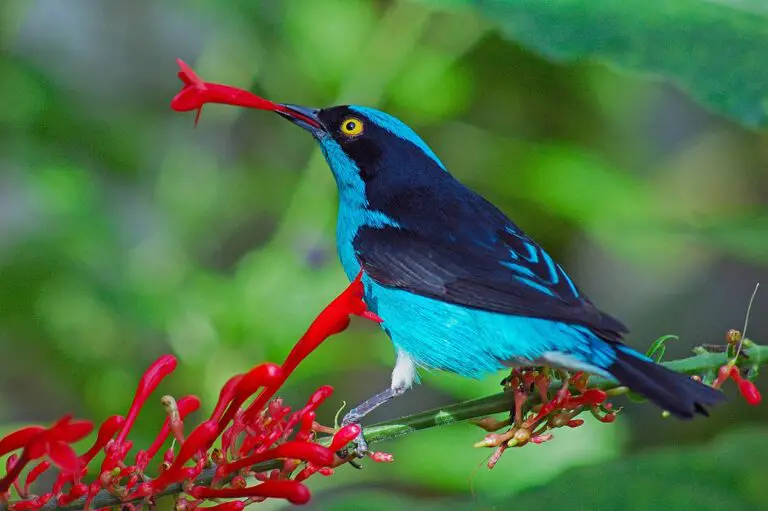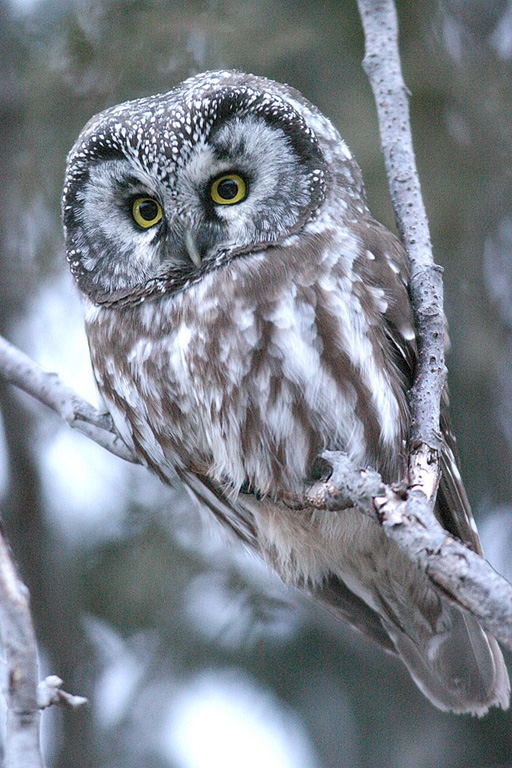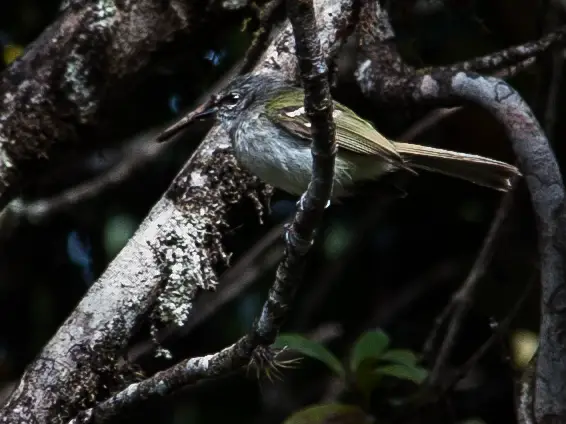Cedar Waxwing (Bombycilla cedrorum)
“Their feathers have red, waxy tips that can be hard to identify unless you’re up close.”
The Cedar Waxwing (Bombycilla cedrorum) belongs to the following scientific classification:
- Kingdom: Animalia
- Phylum: Chordata
- Class: Aves
- Order: Passeriformes
- Family: Bombycillidae
- Genus: Bombycilla
- Species: B. cedrorum
Its conservation status is categorized as “Least Concern,” indicating that it is not currently facing significant threats to its population.
In terms of habitat, Cedar Waxwings can be found in Central America and North America, inhabiting a variety of wooded habitats where they forage for berries and insects.
Here are some interesting facts about the Cedar Waxwing:
- Prey: Cedar Waxwings primarily feed on berries, small fruit, flowers, oozing sap, and insects.
- Name of Young: The young ones of Cedar Waxwings are called chicks.
- Group Behavior: They exhibit social behavior, often seen in flocks.
- Fun Fact: Their feathers have red, waxy tips that can be challenging to identify unless observed up close.
- Estimated Population Size: The estimated population size of Cedar Waxwings is around 64 million individuals.
- Biggest Threat: Collisions with cars and windows pose significant threats to Cedar Waxwings.
- Most Distinctive Feature: Cedar Waxwings are characterized by their rotund bodies and flat crests.
- Distinctive Feature: They have large heads and short bills.
- Wingspan: Their wingspan ranges from 8.7 to 11.8 inches.
- Incubation Period: The incubation period for Cedar Waxwings is typically 12 to 13 days.
- Age of Fledgling: Cedar Waxwing fledglings leave the nest at around 14 to 18 days old.
- Habitat: They inhabit open woodlands with fruiting trees.
- Predators: Predators of Cedar Waxwings include merlins, hawks, grackles, and bullfrogs.
- Diet: Cedar Waxwings are omnivores.
- Lifestyle: They are diurnal birds, active during the day.
- Favorite Food: Berries are among their favorite foods.
- Common Name: Cedar Waxwing is their common name.
- Location: They are found in North America.
- Nesting Location: Cedar Waxwings build their nests in trees on horizontal branches.
- Migratory: Cedar Waxwings are migratory birds.
Regarding their physical characteristics:
- Color: Cedar Waxwings exhibit brown, grey, yellow, red, black, and white coloring.
- Skin Type: Their skin is covered with feathers.
- Top Speed: Cedar Waxwings can reach speeds of up to 25 mph.
- Lifespan: They have a lifespan of about 8 years.
- Weight: Cedar Waxwings weigh approximately 1.1 ounces.
- Length: They measure around 6 to 7 inches in length.
- Age of Sexual Maturity: Cedar Waxwings reach sexual maturity at one year of age.

The Cedar Waxwing (Bombycilla cedrorum) is a bird species native to North America, commonly found in open woodlands with fruiting trees and shrubs. Known for its social nature, Cedar Waxwings are often observed in large flocks year-round, engaging in communal behaviors such as passing fruit to one another while perched on branches. Their distinctive high-pitched whistles can be heard as they fly over water or hover near berry bushes. This summary provides an overview of the Cedar Waxwing’s habitat, diet, behavior, and characteristic vocalizations, offering insights into the fascinating world of this iconic waxwing species.
5 Amazing Cedar Waxwing Facts
- Distinctive Feather Tips: Their feathers possess red, waxy tips, a unique feature that can be difficult to discern unless observed up close.
- Social Nesting Behavior: Cedar Waxwings are highly social birds, often nesting in small colonies, fostering a sense of community among their members.
- Strong Flyers: These birds are adept fliers, capable of reaching impressive speeds of up to 25 mph, allowing them to navigate their environment with agility and precision.
- Serial Monogamy: Cedar Waxwings practice serial monogamy, forming bonds with one partner for each breeding season, demonstrating loyalty and commitment in their reproductive behavior.
- Large and Increasing Population: With an estimated population of around 64 million individuals, Cedar Waxwings boast a sizable population that is steadily increasing, a testament to their adaptability and resilience in their natural habitat.
Where to Find the Cedar Waxwing
Cedar Waxwings are widespread across North America, inhabiting 15 countries including Canada, Mexico, the United States, Costa Rica, and the Bahamas. This migratory species spends its springs and summers in Southern Canada and migrates southward for winters, ranging throughout the US, Mexico, and Central America.
They prefer open woodlands with an abundance of fruiting trees, such as orchards, forest edges, streamsides, swamp edges, and even backyard gardens. Their choice of breeding habitat is primarily dictated by the availability of fruiting trees and shrubs.
When it comes to nesting, Cedar Waxwings typically select trees with horizontal branches or forks situated around six to twenty feet above the ground. Both male and female birds contribute to building a loosely constructed open cup nest made of grass and twigs, lined with moss, grass, and animal hair. This nesting behavior reflects their preference for nesting sites that offer stability and protection for their young.
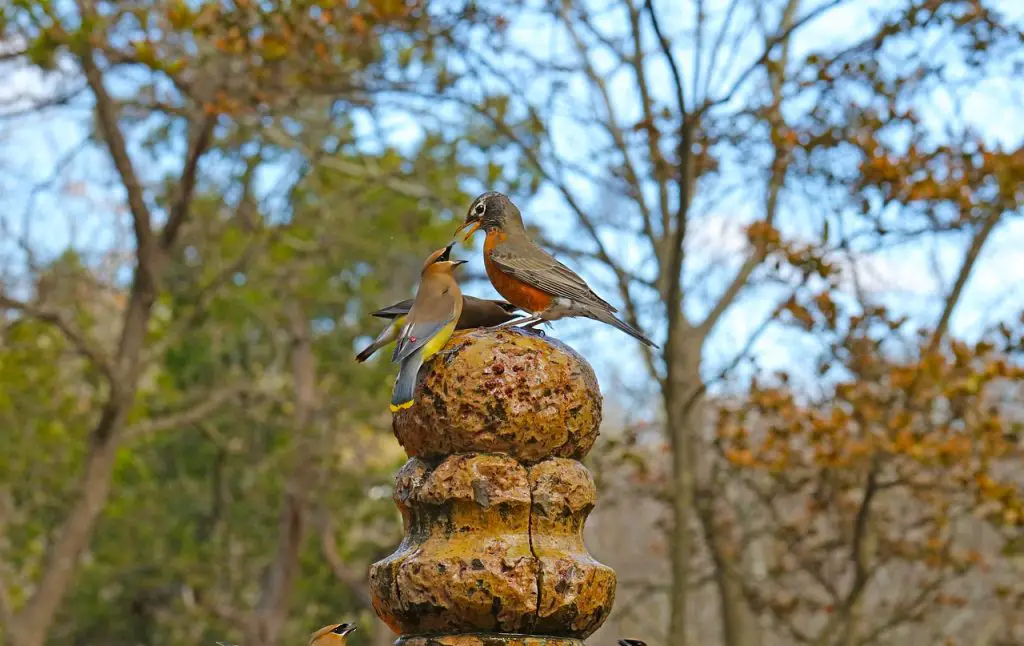
Scientific Name
The Cedar Waxwing (Bombycilla cedrorum) belongs to the Bombycillidae family, which encompasses the waxwings, a group comprising three species of passerine birds. The genus name, Bombycilla, originates from Ancient Greek and Latin, meaning “silk” and “tail,” respectively. This likely refers to the silky texture of their plumage and the tail’s distinctive shape.
As for its specific name, Cedrorum, it is Latin for “of the cedars.” This name might reflect the historical association of Cedar Waxwings with cedar trees or their preference for habitats containing cedar trees.
Size, Appearance, & Behavior
The Cedar Waxwing is a medium-sized passerine bird, measuring between six to seven inches in length and weighing about 1.1 ounces, with a wingspan ranging from 8.7 to 11.8 inches. Sporting rotund bodies with large heads, broad, short bills, and short tails, they possess wide, pointed wings and a flat crest that lays over the back of their head.
Their plumage features a light brown head and chest, a yellow belly, gray wings, and a distinctive black face mask outlined in white. Their tails are also gray with yellow tips, while their wings display red, waxy tips at the end of the feathers.
Highly social creatures, Cedar Waxwings form flocks year-round and often nest in small communities. They are steady and solid fliers, with a flight speed reaching up to 25 mph, characterized by constant wing beats. Their vocalizations, including high-pitched whistles and buzzy trills, are frequently heard, especially during flight.
In terms of migration, Cedar Waxwings exhibit a short to long-distance migration pattern. They breed in Central to Southern Canada and migrate southward for winters, spending their time in the Southern United States, Mexico, and Central America. However, some populations in the northern United States remain in their environments year-round, indicating variability in migration behavior among different groups of Cedar Waxwings.
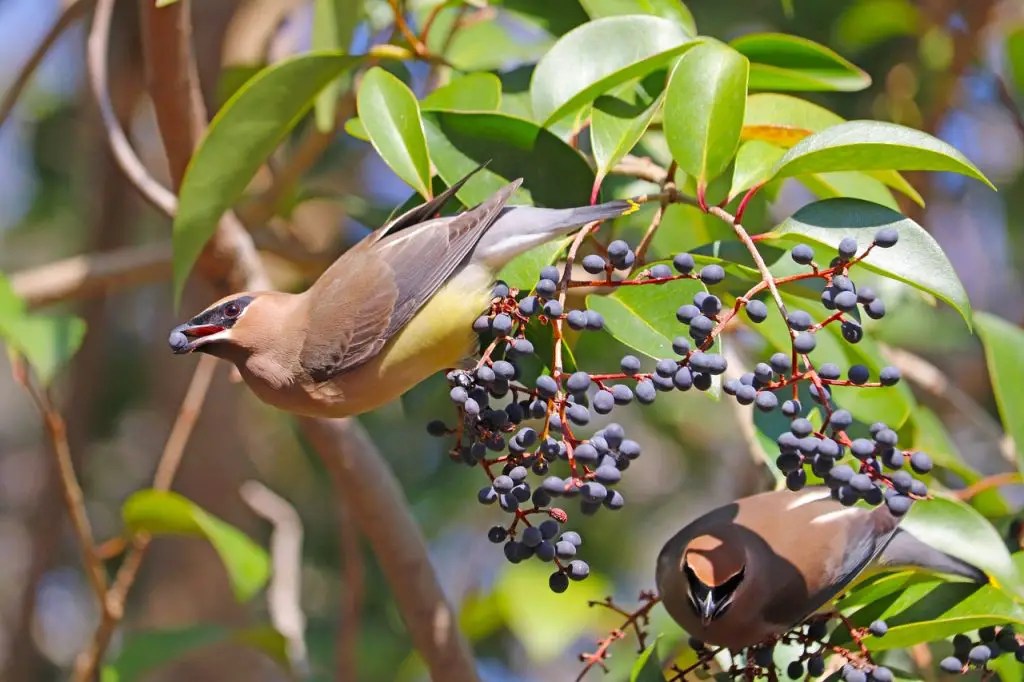
Diet
Cedar Waxwings are omnivorous birds known for foraging in flocks, exhibiting a diverse diet that includes:
- Berries and Small Fruit: Cedar Waxwings feed on a variety of berries and small fruit, including wild cherries and juniper berries, which are abundant in their woodland habitats.
- Flowers: They may also consume nectar from flowers, supplementing their diet with this sugary resource.
- Oozing Sap: In addition to fruit and nectar, Cedar Waxwings are known to feed on oozing sap from trees, especially during certain seasons when sap flow is more abundant.
- Insects: Cedar Waxwings also include insects in their diet, such as beetles, ants, and caterpillars. They are skilled hunters, catching flying insects mid-air and picking insects off foliage while hovering over vegetation.
Their foraging behavior varies throughout the year. During the nesting season, Cedar Waxwings may forage alone or in pairs, focusing on gathering food for their young. However, outside of the breeding season, they typically forage in flocks, displaying cooperative feeding behaviors as they search for food together. This social foraging strategy allows them to efficiently locate and consume a wide range of food resources.
Predators, Threats, and Conservation Status
The Cedar Waxwing (Bombycilla cedrorum) is classified as “Least Concern” by the International Union for Conservation of Nature (IUCN). This designation is attributed to its extensive range and large, increasing population, which does not currently meet the criteria for a threatened status. However, the species faces certain threats, with collisions with cars and windows being identified as the most significant danger. Additionally, Cedar Waxwings could potentially be impacted by climate change in the future, facing risks such as spring heatwaves and wildfires.
In terms of predators, Cedar Waxwings are preyed upon by various species, including merlins, hawks, grackles, and bullfrogs. Blue jays and house wrens are known nest predators. While not much is known about their defensive behaviors, Cedar Waxwings may find safety in numbers, relying on the protection afforded by their social flocking behavior to mitigate predation risks.
Reproduction, Young, and Molting
Cedar Waxwings engage in serial monogamy, forming bonds with only one partner per breeding season. Courtship displays involve various behaviors such as posturing, touching bills, and exchanging food, reflecting their strong pair-bonding rituals. Their nesting season typically begins late, not commencing until mid-summer, and they have the capacity to raise two broods per year.
During the nesting period, females lay a clutch of two to six eggs, usually averaging three to five. These eggs are pale blue-gray with brown and black spots. Incubation, lasting 12 to 13 days, is primarily carried out by the females, although both parents participate in feeding the nestlings.
Young Cedar Waxwings leave the nest approximately 14 to 18 days after hatching and reach reproductive maturity by around one year of age. In the wild, Cedar Waxwings can live up to eight years, exhibiting a relatively long lifespan for a passerine species.
Population
The global population of Cedar Waxwings is estimated to consist of approximately 64 million mature individuals. Recent trends indicate a notable increase of over 7% in their numbers over the past decade, with a continuing slow upward trend. Moreover, their population does not exhibit any significant fluctuations or fragmentations, suggesting a stable and healthy status for this species across its range.
Conclusion
Cedar Waxwings are thriving, with a global population estimated at 64 million mature individuals. Their numbers have been steadily increasing over the past decade, reflecting a healthy and stable status for the species. Despite facing threats such as collisions with cars and windows, Cedar Waxwings demonstrate resilience, benefiting from their extensive range and adaptable nature. With their striking appearance, social behaviors, and fascinating nesting habits, Cedar Waxwings remain a cherished and iconic species in North American avifauna.
